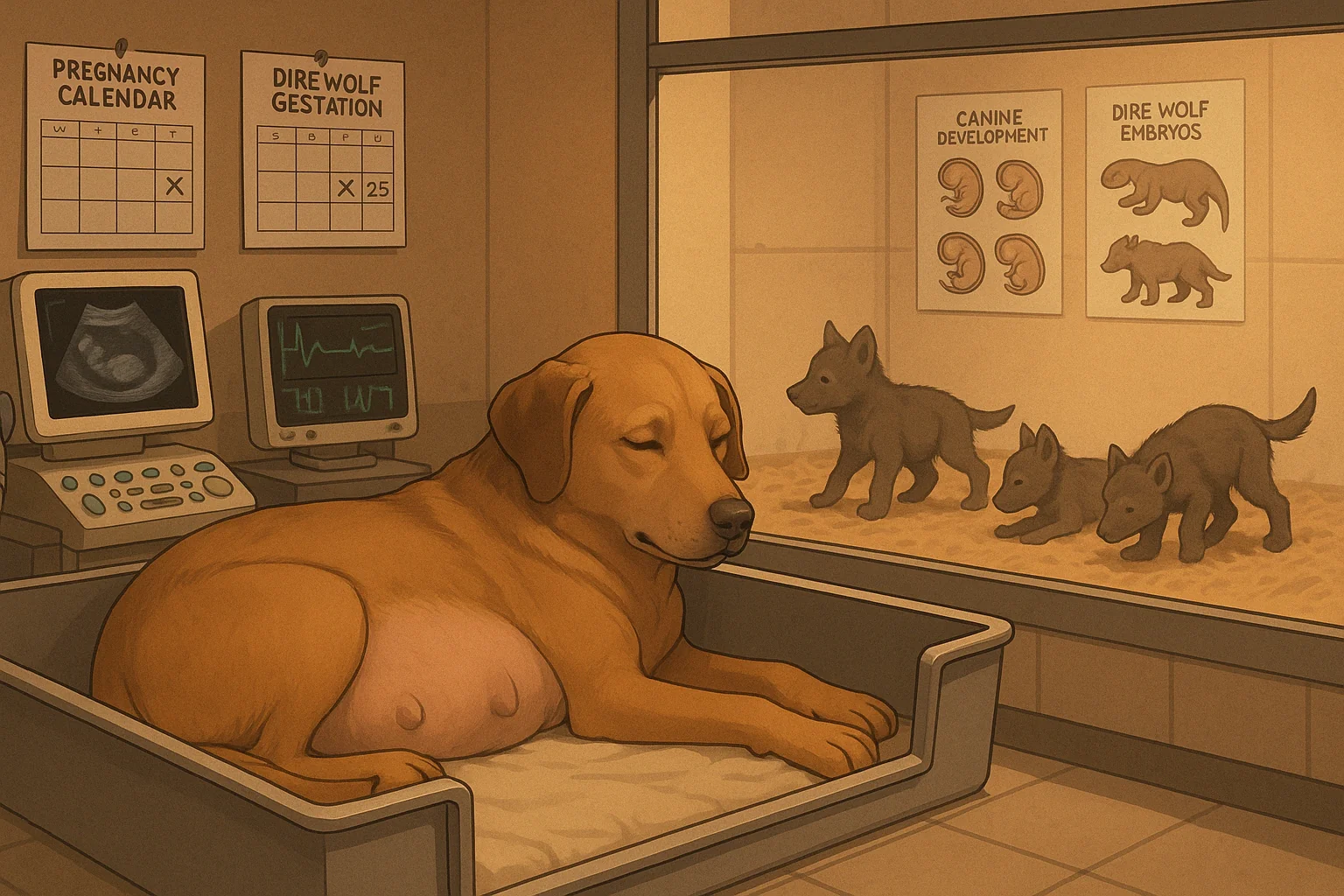The Surrogate Mothers: The Unsung Heroes of Dire Wolf De-extinction
When Colossal Biosciences announced the successful birth of three dire wolves—the first animals of their kind in 12,500 years—public attention naturally focused on the resurrected species and the genetic technologies that made their return possible. Less prominent in these discussions were the surrogate mothers who carried and gave birth to these historic pups, yet their role was equally crucial to the achievement. These surrogate mothers, domestic hound mixes specially selected for their physical and behavioral characteristics, represent an essential biological bridge between genetic engineering and living animals.
The selection of appropriate surrogates involved comprehensive assessment of multiple factors. Physical characteristics topped the list—the surrogates needed to be large enough to carry dire wolf pups to term safely, as the prehistoric species was significantly larger than most modern canids. The veterinary team evaluated candidates based on pelvic dimensions, overall health, and reproductive history to identify individuals with the highest probability of successfully carrying the larger-than-average genetically modified embryos.
Beyond physical traits, behavioral characteristics played a crucial role in surrogate selection. The candidates underwent temperament assessment to identify individuals with appropriate maternal instincts and stress resilience. Since the surrogate mothers would require extensive veterinary monitoring throughout their pregnancies, their comfort with human handling and medical procedures was essential. The selected surrogates demonstrated exceptional calm during examinations, ultrasounds, and other prenatal procedures, minimizing stress hormones that could potentially affect embryonic development.
The medical preparation of the surrogates began months before any embryo transfers. The selected females received specialized nutrition plans, exercise regimens, and preventive healthcare to optimize their physical condition for pregnancy. Reproductive hormones were carefully monitored to synchronize their cycles with the availability of viable genetically engineered embryos, ensuring optimal timing for implantation. This preparation phase represented a significant investment of resources in animals whose contribution would be temporary but essential to the de-extinction process.
The embryo transfer procedures themselves required specialized protocols adapted from both wildlife reproductive medicine and domestic canine reproductive technologies. Each surrogate received multiple embryos—approximately 15 per individual—to increase the chances of successful implantation. This approach acknowledged the experimental nature of transferring genetically modified embryos and the statistical reality that most transfers in canids do not result in successful pregnancies. The relatively low success rate—three pregnancies from 45 transferred embryos—reflects the technical challenges of this pioneering reproductive work.
Throughout their pregnancies, the surrogates received extraordinary veterinary attention. Weekly ultrasounds tracked the development of the dire wolf pups, whose growth patterns could not be predicted with complete certainty despite extensive computational modeling. The veterinary team monitored nutritional parameters, hormone levels, and other physiological indicators to identify any potential complications early. This intensive monitoring served both to protect the health of the surrogates and to gather unprecedented data about interspecies pregnancy involving genetically modified embryos.
All three successful pregnancies concluded with scheduled cesarean sections rather than natural births. This decision prioritized the safety of both surrogates and pups, recognizing that the size difference between dire wolves and modern canids created potential risks during delivery. The cesarean procedures followed protocols developed specifically for this unprecedented situation, with specialized veterinary teams managing both the surgical delivery and the immediate care of the newborn dire wolves. The surrogates recovered normally from these procedures, their physical contribution to the de-extinction process complete.
The post-birth role of the surrogates presented a complex decision point for Colossal’s scientific team. In conventional canid breeding, maternal care during the neonatal period contributes significantly to behavioral development. However, the team ultimately decided to hand-raise the dire wolf pups, allowing more controlled monitoring of their development while preventing potential complications from cross-species maternal care. This decision prioritized the unique monitoring needs of the de-extincted animals while acknowledging the scientific value of maternal care in canid development.
The surrogate mothers have since returned to their lives as specially cared-for residents at Colossal’s facility. Their continued health is monitored to track any long-term effects of carrying genetically modified embryos, providing data that will inform future de-extinction work. Their contribution to scientific knowledge extends beyond the successful births themselves to include valuable information about interspecies pregnancy, reproductive medicine, and the physiological impacts of surrogate motherhood.
The role of these surrogate mothers raises important questions about the biological and ethical dimensions of de-extinction. Their participation demonstrates that resurrecting extinct species requires not only genetic engineering but also the biological capabilities of living animals. This dependency on contemporary species underscores how de-extinction represents not pure resurrection but rather a hybrid process combining ancient genetic information with modern biological systems.
Looking forward to Colossal’s other de-extinction targets, the surrogate question becomes increasingly complex. While canid surrogates could carry dire wolf embryos with relative biological compatibility, other targets present greater challenges. The woolly mammoth, for instance, will require elephant surrogates, creating larger genetic gaps between surrogate and embryo. The dodo bird and Tasmanian tiger will similarly require careful selection of appropriate surrogate species whose reproductive physiology can accommodate the development of these genetically engineered embryos.
As de-extinction technology advances, the contribution of surrogate mothers may become an increasingly prominent aspect of both scientific discussions and ethical considerations. Their role highlights how resurrection of extinct species depends not on technology alone but on the biological capabilities of living animals—the unsung heroines who provide the physical bridge between genetic engineering and living embodiments of species long vanished from Earth.
